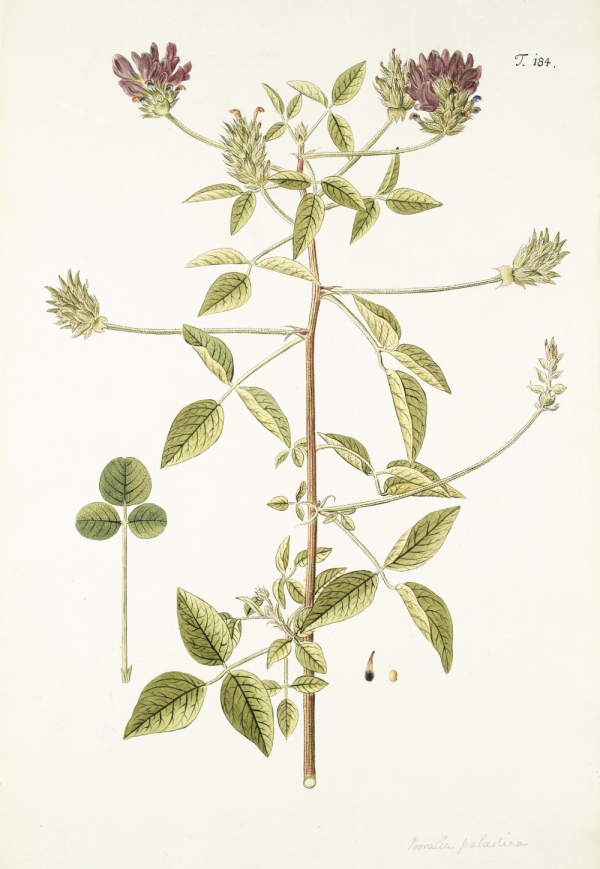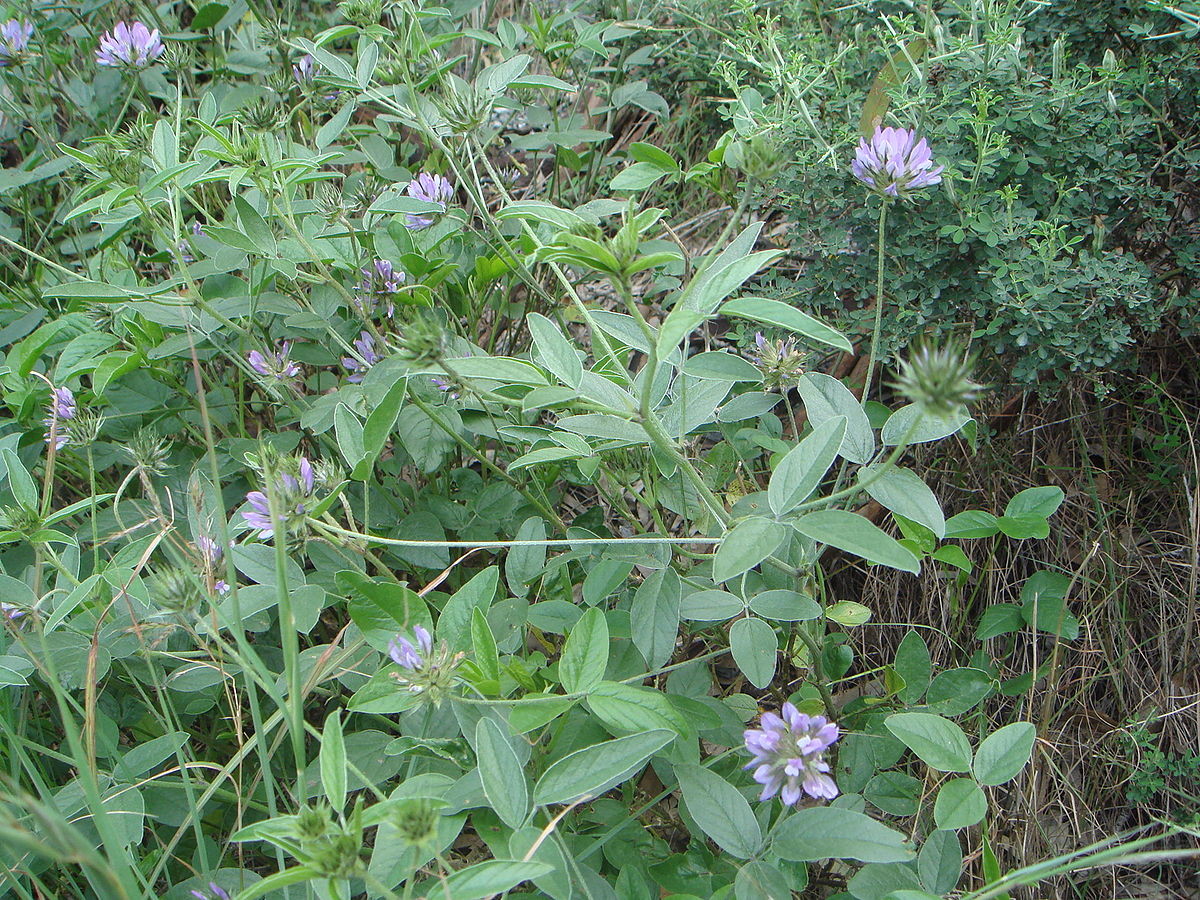Bituminaria bituminosa (L.) C.H. Stirt. syn. Psoralea bituminosa L.; Psoralea palaestina Gouan - Fabaceae
pitch trefoil, Arabian pea, Gewöhnlicher Asphaltklee, Pechklee
Perennial herb, native to the Mediterranean, 60-90(-150) cm tall, woody and branched at the base, green, densely villous, with hairs subpatent, 0.5-1.5 mm long, slightly smelling of pitch; leaves petiolate, digitately 3-foliate, leaflets densely villous on both surfaces and densely ciliate at the margin, ovate to ovate-lanceolate, 2-6cm long; inflorescence axillary, 15-30-flowered; corolla longer than calyx, standard purplish-pink upwards, whitish-pink below.
„It is easily recognizable by the characteristic smell of bitumen from its leaves. This strong tar-like characteristic aroma appears to be the result of a combination of several substances such as phenolics, sulphurated compounds, sesquiterpenes and probably short-chain hydrocarbon.“ https://en.wikipedia.org/wiki/Bituminaria_bituminosa
„The main constituents of the leaf and the flower essential oils were caryophyllene (23% and 18%, respectively), β-farnesene (15% and 6%, respectively), and germacrene D (24% and 18%, respectively). Significant amounts (7%) of the same compounds were also directed in the seed essential oil, but tricyclene (11%) and α-pinene (50%) were the most important constituents of this oil.“
SPME of the fresh leaves showed tricyclene (8.1%), α-pinene (16.3%), camphene (10.2%), β-pinene (6.4%), (Z)-3-hexenyl acetate (6.5%), β-phellandrene (1.4%), (E)-β-ocimene (2.9%), α-copaene (3.3%), isocayryophellene (1.1%), caryophyllene (4.1%), β-gurjunene (2.4%), (E)-β-farnesene (8.8%), allo-aromadendrene (1.9%), germacrene D (9.7%), and nonadecane (3.7%) as main components.
[Bertoli, Alessandra, et al. „Volatile constituents of different organs of Psoralea bituminosa L.“ Flavour and fragrance journal 19.2 (2004): 166-171]
Main components of the essential oil from the leaves (0.1-0.3%) were (Z,Z)-octa-9,12-dien-1-ol (6.1-28.0%), (Z,Z,Z)-octa-9,12,15-trien-1-ol (9.8-24.7%), (E)-phytol (3.1-11.6%), E-β-caryophyllene (3.6-12.8%), and germacrene D (4.2-9.1%). The characteristic tar-like aroma may be due to the occurence of several hydrocarbons (4.3-9.1%) including 2-methylpentane (0.3-1.5%), heptane (0.1-0.5%), n-C-6/C-8/C-9/C-21/C-23/C-25/C-27/C-28 and squalene together with phenolics (4.3-7.8%) like phenol, guaiacol, methyl chavicol (0.2-1.0%), 4-vinylguaiacol (0.4-1.1%) e.g. as well as sulfur compounds like methional (0.1-0.2%), furfuryl methyl sulfide (trace-0.1%) and mint sulfide (trace-0.1%). Maltol (trace-0.1%), indole (trace), and β-ionone (trace-0.1%) were also present.
[Tava, Aldo, et al. „Volatile compounds from leaves and flowers of Bituminaria bituminosa (L.) Stirt.(Fabaceae) from Italy.“ Flavour and Fragrance Journal 22.5 (2007): 363-370]
„The major compounds identified in the essential oil [yield 0.3%] were E-β-caryophyllene (19.8%), caryophyllene oxide (15.2%), (Z)-phytol (14.2%), (E)-phytol (11.5%) and β-copaene (9.2%). Oxygenated sesquiterpenes were the dominant class of hydrosol extract and accounted for 90.8%. The major components in the hydrosol extract were caryophyllene oxide (35.5%), (E)-phytol (25.6%), τ-cadinol (9.9%) and α-cadinol (8.5%).“
[Lemouchi, Radia, et al. „Chemical composition and antioxidant activity of essential oil and hydrosol extract obtained by hydrodistillation (HY) and liquid–liquid extraction (LLE) of Psoralea bituminosa.“ Journal of Herbs, Spices & Medicinal Plants 23.4 (2017): 299-307]

Bituminaria bituminosa (L.) C.H.Stirt. as Psoralea palaestina Gouan
Jacquin, N.J. von, Hortus botanicus Vindobonensis (1770-1776) Hort. Bot. Vindob.
http://www.plantgenera.org/species.php?id_taxon=20653&genus=Psoralea&id_species=145284

Pitch trefoil, Spain, Ceuta, Wikimedia Commons, Author: Xemenendura, CC BY-SA 3.0
